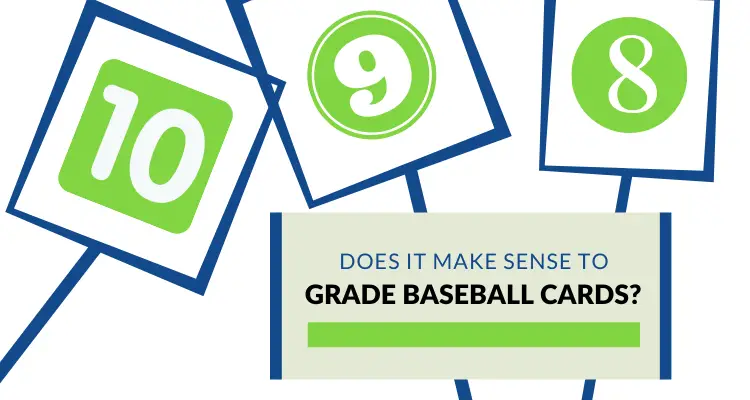 Ryan Barone (@ballcardgenius, Card Expert) is a lifelong member of the hobby. He has been quoted in PSA Magazine, and his content has regularly been mentioned in “Quick Rips” (the Topps RIPPED Newsletter) and across other hobby publications. hello@ballcardgenius.com; Last Time Ago LLC dba Ballcard Genius.
Ryan Barone (@ballcardgenius, Card Expert) is a lifelong member of the hobby. He has been quoted in PSA Magazine, and his content has regularly been mentioned in “Quick Rips” (the Topps RIPPED Newsletter) and across other hobby publications. hello@ballcardgenius.com; Last Time Ago LLC dba Ballcard Genius.
Affiliate Disclosure: This post contains affiliate links. As I am a part of the eBay Partner Network and other programs, if you follow these links and make a purchase, I’ll receive commission. As an Amazon Associate, I earn from qualifying purchases.
The idea of baseball card centering is an easy one to grasp—the photo and design should be centered on the card. But when it comes to grading cards, there is a deeper level of knowledge required if you want to improve your chances of receiving a 10.
For instance, when looking at PSA centering standards and those of other grading companies, you’ll often see things like 55/45, 60/40, 75/25, 90/10, and other ratios. But what does it all mean?
At a basic level, each of these groups of numbers adds up to 100. Thus, if you think about 100 representing the entire card, if you split it perfectly in half, 50% of the card will be on each side (or top and bottom). That is, an even proportion of the card, or 50/50.
On the other hand, if the card is pushed more to one side or the other, it might be 75% to the left, leaving 25% on the right, or, 75/25.
All in all, you want your card centering to be as close to 50/50 as possible. The larger the difference between the two numbers (say, 90/10) the more off-center it is said to be.
Card Centering Examples
While knowing all of that is great, it means nothing without a visual. One option is to fire up your favorite card centering app. The other is to take a look at what’s out there.
Here are a number of different baseball card centering examples.
50/50 Example
Let’s start with perfection. For a card that is blessed with 50/50 centering, you’ll see equal border weights on all side of the card. The left is identical to the right, and the top is identical to the bottom.
PSA 9 BARRY BONDS 1996 TOPPS FINEST REFRACTOR #G105 GOLD *50/50 CENTERING AROUND #ad #thehobby https://t.co/pOyZRItBUD pic.twitter.com/Ei4saUHIsB
— Card Finder (@Cardfinder123) August 10, 2023
Cards that have a solid border all the around the card make it easy, but other examples, like this one make it a little more difficult to notice the perfection:
1982 TOPPS TRADED #98T CAL RIPKEN JR. RC PSA 10 GEM MINT – PERFECT CENTERING https://t.co/z2O225p0vc pic.twitter.com/RvTJjTLnU0
— PSA Gem Mint 10 (@GEMMT10) February 23, 2017
While the top is nearly a complete border, you can see the others break off a bit. Even so, there is enough of a border to know that, if, you continued an imaginary line down where the design curves, the rest of the edge would be complete.
Another thing to note with the 1982 Ripken example above…when giving a card the eye test, you’re looking at the design element that is on the outside of the card. Meaning, with the two lines on the left side of this card, you might get fooled into looking at the inside line and thus thinking it was off-center.
60/40 Centering Example
Now, the 50/50 example is the easiest to identify…it’s also the one that will be harder to find for most low pop cards. As a result, you might see a 60/40 and think, this looks pretty good.
One important note though before we continue. When it cards to getting cards graded, it’s crucial you’re honest with yourself and what you are seeing. Yes, we all want gem mint cards, but you’ll end up wasting a lot of money if you can’t accept the fact that a card just doesn’t have the centering it needs to score a 10.
So, with that, let’s take a look at a couple of 60/40 centering examples.
JUST GRADED A 9…BUT WHY?
— TheGradingAuthority (@tgacards) January 12, 2023
With this Judge card, these factors led to the 9 grade:
• 60/40 centering top to bottom
• Surface blemish on front side
We at TGA feel that the Pristine 10 is reserved only for those cards that truly earn it.
What will be your next 10? pic.twitter.com/PZEaLp6xpV
I chose this specific example because it’s important to remember that a card has four sides. Of course, we all know a card is shaped as a rectangle, so that should be a given, but if you’re like me, you might first look at left to right centering and bypass top to bottom.
With this Aaron Judge, a first look at the left to right centering would get you excited. But, due diligence and looking at the top bottom centering will – if you’re being honest with yourself – tell you centering is closer to 60/40 (60 top and 40 bottom).
60/40 centering both ways. 50/50 on the back
— Raul ? (@SlagaCards) February 12, 2022
Beautiful example, new label. Mint condition rookie of the greatest.
$6250 shipped. Cheapest up is $7k out of Canada. @HobbyConnector @sports_sell pic.twitter.com/tCnGTDyns3
And with this Michael Jordan, it doesn’t matter which side you look at first, because as the tweeter accurately states, 60/40 centering both ways (and 50/50 centering on the back).
<60/40 centering both ways. 50/50 on the back
— Raul ? (@SlagaCards) February 12, 2022
Beautiful example, new label. Mint condition rookie of the greatest.
$6250 shipped. Cheapest up is $7k out of Canada. @HobbyConnector @sports_sell pic.twitter.com/tCnGTDyns3
75/25 Centering Example
As we move further away from 50/50, bad centering becomes a little more obvious, and that’s certainly the case with the 75/25 split. In most cases, such centering will leave you with one thick border and one very thin border.
This 1969 Topps Mickey Mantle fits that decription, with the thick top occupying the “75” and the very thin bottom maintaining the remaining “25.”
Has a wax stain on the front. It makes me nervous for grading lol. Sharp otherwise. 75/25 centering top to bottom though. pic.twitter.com/yig8GCIRvc
— VegasFinds777 (@VegasFinds777) May 21, 2020
I won’t spend too much time here as again, you can tell fairly easily that this card is not centered 50/50 or even 60/40, and that’s the case with many others like it.
90/10 Centering Example
Last but not least, you might not even need to see an example of 90/10 centering, but just to drive the point home, here are a few:
As far as centering goes, what would m you call this @Topps ?? Like 90-10 bottom to top? pic.twitter.com/xLJ7C9ugzV
— Jason Urdahl (@TheCoachPearl) December 15, 2022
Sadly, when it comes to 90/10 centering, there is barely a border at all. How a card (especially a modern card) gets printed like that in today’s card game is anyone’s guess. But, just a reminder to never take card condition for granted, and remember that of all of the different ways to buy baseball cards, and even if buying boxes and packs, centering could be as much 90/10 as could be 50/50.



